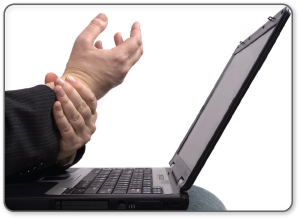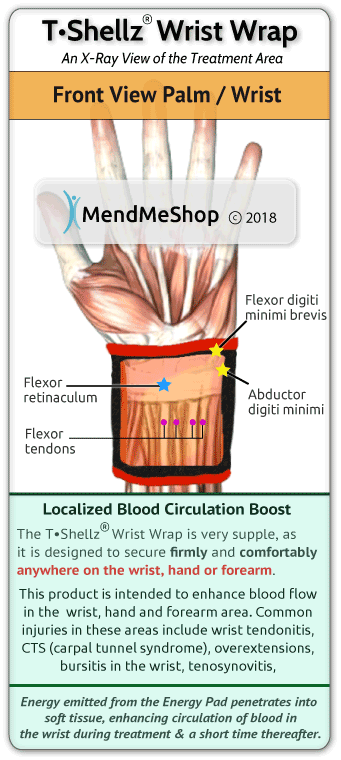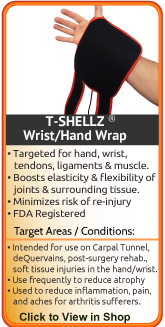|
|
Flexor Tendonitis/TendinitisTendon Injury of the Wrist / HandTendons are vital structures connecting muscles to bones. In the wrist and palm of our hands, there are two sets of tendons, called flexor tendons, which are responsible for the fine dexterous movements of the hand. They are located on the palm side, and are made up of tissue called collagen and elastin, ensuring that the tendon is both tough but flexible. Tendons need to glide smoothly, allowing the powerful contraction of the muscle to move the intended bones and joints, and hence are enclosed by synovium, a thin sheath of smooth tissue. When the tendons become irritated, their ability to glide within these compartments is restricted, causing wrist and hand pain during movement and tenderness when direct pressure is applied. Tendon fibers can tear apart in much the same way a rope becomes frayed. Once a tendon becomes frayed, an inflammatory response is triggered; over time an inflamed tendon can become thick, bumpy and irregular. Without proper rest and time to heal, a damaged tendon can become permanently weakened. CausesIf tendons are stressed enough from excessive or unconditioned use, the sheath lining can become inflamed and movements may be painful to varying degrees as the tendons glide through the inflamed sheath. Tendinitis can be caused from overuse of a limb during an activity. For example, if a person undertakes a massive spring cleaning, the wrist is usually held in a hyper-extended position as the palm exerts the pressure. The extensor tendons at the wrist level are strained and tendon sheaths become inflamed. In contrast, planting a winter garden may involve more forceful wrist flexion as small spades are repeatedly drawn toward the body. This strains the wrist flexor tendons which may become painful with wrist motion, tender to direct pressure and possibly swollen. Prevention Prevention of flexor tendinitis is exercised simply by not overdoing any activities that use a lot of wrist motion. (ie. cleaning, gardening, typing, filing and writing). Be careful about suddenly increasing the time spent on these activities, as your tendons are not properly conditioned to the added stress. Close attention also should be paid to the positioning of the wrist and hand - try to maintain the wrist in a neutral position and avoid any excessive flexing (bending the wrist forward) and extending (bending of the wrist backward). TreatmentRest the area, apply cold compression for 10-20 minutes at a time for at least 3 times a day. Do this to the wrist/hand area for the first day up to 3 days. Circulation Boost may be used after the acute swelling is improved and rest prevents further tendon injury. The TShellz Wrap® will stimulate blood flow and minimize the build up of scar tissue around the tendon during the healing process, helping the tendon heal more quickly. The trick to any tendon injury is getting it to heal with minimal scar tissue formation and with as much realignment of tendon fibres as possible - something Circulatory Boost (by using the TShellz Wrap®) and Ice Packs are great at! Even with optimum healing there is always less elasticity in a previously injured tendon. The trick is to make sure you heal this the best you can, that way your chance of re-injury down the road is much lower than average. Wrist Tendonitis Treatment The trick to any tendon injury is getting it to heal with minimal scar tissue formation and with as much realignment of tendon fibers as possible. To achieve this, your doctor will most likely recommend up to 6 months of conservative treatments. Even with optimum healing there is always less elasticity in a previously injured tendon. The trick is to make sure you heal it the best you can, that way your chance of re-injury down the road is much lower than average - which is well over 50%. The wrist will continue to be inflamed until you allow it to rest from the pain causing activity. Continued damage will cause chronic inflammation, secondary adhesion and general degeneration of the tendon. The tendon sheath itself will probably be injured as the tendon swells, increasing the pain of the condition. When treating the wrist tendon(s), rest the area, apply cold compression for 10-20 minutes at a time for at least 3 times a day. Do this to the injured area for the first day to 3 days of inflammation or longer until the swelling calms down. The Wrist TShellz Wrap® (a Circulation Boost device) may be used after the acute swelling has improved; the TShellz Wrap® will stimulate blood flow in the local area, while also warming up the tissue. It is known that warmed tissue will experience a larger range of motion and increased extensibility and this is exactly what you want when you are trying to recover from a soft tissue injury. Increased extensibility and flexibilty in soft tissue means it is less likely to strain or tear further during activity, and less re-injury during your recovery means your recovery will be much faster. A faster recovery minimizes the build up of scar tissue around the tendon during the healing process, while also reducing the risk and severity of overcompensation pain and secondary injuries. Basically, the value of a faster recovery is often underestimated, as the impact of chronic injuries can quickly spiral out of control. Why Wrist Tendonitis Can Persist Often when a tendon injury occurs, the injured area is rested a bit, a pain killer is taken and we continue on with our normal activities. If the strain was minor, the body may be able to heal the tendon fibers normally. Unfortunately, this is not the usual result because the injured tendon is being used instead of rested. Because of the stress on the tendon, the body heals the injured fibers by binding them together with fibrotic adhesions or scar tissue. This is done in an attempt to prevent further damage to the injured area. It is a normal protective response of the body, but buildup of scar tissue can and does become a big problem over the long term. Scar tissue buildup is one of the main reasons we advocate the use of a TShellz Wrap® over the long term once the swelling is down. Much of the pain may have disappeared with the swelling, but that does not mean your tendonitis has healed. The trick is to continue boosting blood flow to the area on a daily basis, helping keep tissues in the area flexible and less likely to strain while your tendon(s) continue to build up strength. A General Breakdown of Home Conservative Treatment Options
Conservative Treatment Tools Our Clients Have Used to Help | Tendon Injury Facts: When the tendon gets inflamed it is known as tendonitis, and when the tendons are chronically overused, it may lead to microscopic tears in the collagen matrix and causes a gradual weakening of the tissues. Achilles tendonitis is a common injury among runners, as the Achilles tendon is responsible for helping you lift off the ground with each stride. As computers become ever more important elements of the work place and everyday life, incidents of wrist tendonitis are on the rise. Oral Medications can mask the pain but do not aid in the healing of tendonitis. Anti-inflammatories and pain killers can mask the pain and indirectly cause tendonitis to worsen. Ice and Compression treatments are the easiest and most effective treatments for tendonitis.      |







